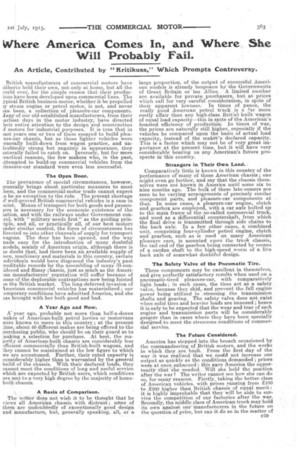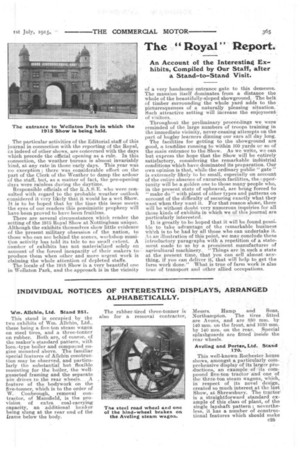Where America Comes In, and Where She Will Probably Fail.
Page 9

Page 10

Page 11

If you've noticed an error in this article please click here to report it so we can fix it.
An Article, Contributed by "Kritikuss," Which Prompts Controversy.
British manufacturers of commercial •motors have &heft° held their own, not only at home, but all the vorld over, for the simple reason that their producions have been developed upon commercial lines. The ypical British business motor, whether it be propelled ry steam engine or petrol motor, is not, and never lasbeen, a collection of pleasul-e-car components. &any of our old-established manufacturers, from their .arliest days in the motor industry, have directed heir entire attention to the design and construction rf motors for industrial purposes. It is true that in )ast years one or two of them essayed to build pleaure-car chassis, but as those lighter vehicles were .enerally built-down from wagon practice, and unloubtedly strong but ungainly in appearance, they taturally failed to catch on. Inversely, but for more Iractical reasons, the few makers who, in the past, trtempted to build-up commercial vehicles from the deasure-car standard were even less successful.
The Open Door.
The prevalence of special circumstances, howevee, cenerally brings about particular measures to meet hem, and the commercial-motor trade cannot expect
be an exception to the rule. The present shortage ,f well-proved British commercial vehicles is a case in ioint. Means of transport for both goods and passencers is necessary for the economic existence of the iation, and with the railways under Government conrol, with "military needs first" as the guiding priniple, and all, or practically all, of our best motors alder similar control, the force of circumstances has lirected us into other channels of supply for transport vagons. The door has been opened, and the way nade easy for the introduction of many doubtful nodels, mainly of American origin, although there is io doubt that, had there been an available supply of nen, machinery and materials in this country, certain ndivicluala would have disgraced the industry's past reditable records by the assembling of many ill-conidered and flimsy chassis, just as much as the Amen:an manufacturers' reputation will suffer because of ;ome of the deplorable contraptions now being foisted in the British market. The long-deferred invasion of kmerican commercial vehicles has materialized ; our ,emporary conditions have admitted America, and she las brought with her both good and bad.
A Year Ago and Now.
A' year ago, probably not more than half-a-dozen makes of American-built petrol lorries or motorvans were known to users in this country ; at the present :ime, about 40 different makes are being offered to the purchasing public, who should be on their guard as to making a selection for purchase. At best, the majority of American-built chassis are considerably less 3fficient commercially than British-built wagons, and they cannot be maintained at the low figure to which we are accustomed. Further, their rated capacity is considerably higher than is warranted by the general build of the chassis. With their declared loads, they ca,nnot meet the conditions of long and useful service which are expected by British users, which conditions are met to a very high degree by the majority of-homebuilt chassis.
A Basis of Comparison.
The writer does not wish it to be thought that he views all American chassis with distrust ; same of them are undoubtedly of exceptionally good design and manufacture, but, generally speaking, all, or a large proportion, of the output of successful American models is already bespoken by the Governments of Great Britain or hem Allies. A limited number are available for private purchasers, but at prices which call for very careful consideration, in spite of their apparent lowness. In times of peace, the really good American petrol truck is a far more costly affair than any high-class British built wagon of equal load capacity—this in spite of the American's boasted efficiency of production. In times of war, the prices are naturally still higher, especaally if the vehicles be compared upon the basis of actual load capacity, instead of the makei's declared capacity. This is a factor which may not be of very great importance at the present time, but it will have very considerable bearing on any American's future prospects in this country.
Strangers in Their Own Land..
Comparatively little is known in this country of the performance of many of these American chassis ; one might even go further, and say that the chassis themselves were not known in America until some six to nine months ago. The bulk of these late-comers are seen to be varying arrangements of precisely similar component parts, and pleasure-car components at that. In some cases, a pleasure-car engine, clutch and gearbox are employed, with a car axle bolted up to the main frame of the so-called commercial truck, and used as a differential countershaft, from which the final drive is transmitted through side chains to the back axle. In a. few other cases, a combined unit, comprising four-cylinder petrol engine, clutch and gearbox, such as is used on many American pleasure ears, is mounted upon the truck chassis, the tail end of the gearbox being connected by means of a cardan shaft to the high-speed worm of a live back axle of somewhat doubtful design.
The Safety Valve of the Pneumatic Tire.
These components may be excellent in themselves, and give perfectly satisfactory results when used on a pneumatic-tired pleasure-car, with comparatively light loads ; in such cases, the tires act as a safety valve, because they skid, and prevent the full engine power being utilized in . stressing the transmission shafts and gearing. The safety valve does not exist when solid tires and heavier loads are imposed ; hence it is only to be expected that the wear and tear of such engine and transmission parts will be considerably greater than in cases where they have been specially designed to meet the strenuous conditions of commercial service.
The Future Considered.
America has stepped into the breach occasioned by the commandeering of British motors, and the works in which they are built. From the first day of the war it was realized that we cotid not increase our output as quickly as the conditions demanded ; prices were at once enhanced ; this gave America the opportunity that she needed. Will she hold the position after the war ? The writer cannot see how she can do so, for many reasons. Firstly, taking the better class of American vehicles, with prices ranging from £100 to £300 higher than British chassis of equal merit : it. is highly improbable that they will be able to survive the competition of our factories after the war. Secondly, the middle class of American truck may hold its own against our manufacturers in the future on the question of price, but can it do so in the matter of
personal service ? Are the builders of that class of truck making arrangements for keeping efficient repairing staffs in this country, together with such adequate stocks of spare parts as will entirely avoid any risk of a vehicle being held up pending the arrival of replacements from over the water? Unless such arrangements are made, no American vehicle builder can hope to retain ally hold on our market And, thirdly, the really shoddy American truck will die dishonoured ; there will be no need for spare parts or personal service after the war.
The question of prime importance to Briti!sh buyers of American vehicles is, will their makers establish service deno+s in this country and maintain them after the war? The writer thinks not, except in a fen cases, for the simple reason that many of these Amen can productions are not being handled by the mane facturers themselves, but by astute business men an capitalists, who, realizing the opportunity for makim big profits immediately, have made their arrange ments accordingly. The conduct of a steady busines with moderate profits does not appeal to this type c man ; the future has no attractions for him. While h can sell chassis by the hundred he is an enthusiast, bp when the present high rate of demand has passed, am orders. come in by ones. and twos, he will drop th business like hot coals. Therein lies the safety c our home builders.
The particular activities of the Editorial staff of this journal in connection with the reporting of the Royal, as indeed of other shows, are concerned with the days which precede the official opening as a rule. In this connection, the weather bureau is almost invariably kind, at any rate in those 'early days. This year was no exception ; there was considerable effort on the part of the Clerk of the Weather to damp the ardour of the staff, but, as a matter of fact, the pre-opening days were rainless during the daytime.
Responsible officials of the R.A.S. E. who were consulted with regard to the probable weather outlook considered it very likely that it would be a wet Show. It is to be hoped that by the time this issue meets the eyes of our readers this pessimistic prophecy will have been proved to have been fruitless.
There are several circumstances which render the setting of the 1915 Royal Show at Nottingham unique. Although the exhibits themselves show little evidence of the present military obsession of the nation, to those who can see behind the scenes, workshop munition activity has told its tale to no small extent. A number of exhibits has not materialized solely on account of the forced incapacity of their makers toproduce them when other and more urgent work is claiming the whole attention of depleted staffs.
The locale of the 1915 Show is a very beautiful one in Wollaton Park, and the approach is in the vicinity


































